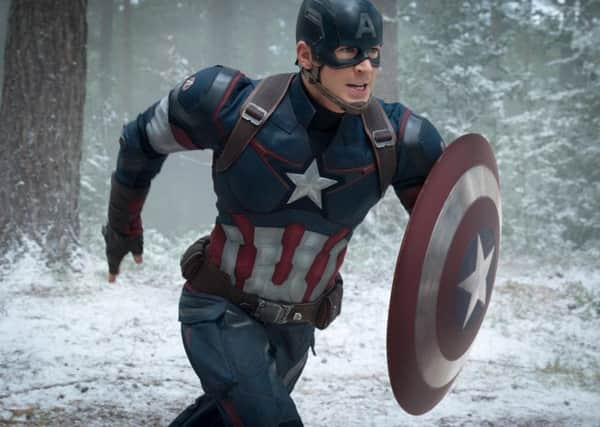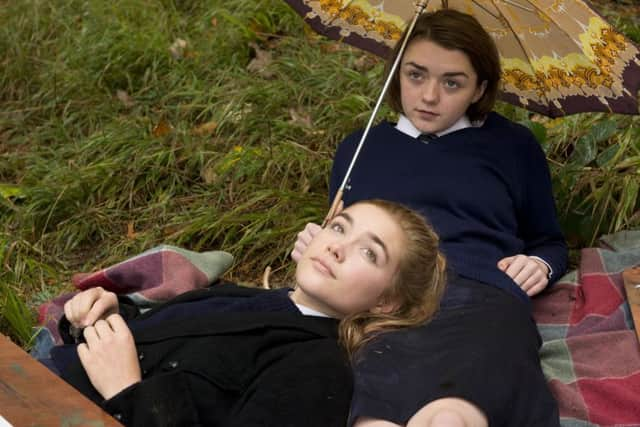Film reviews: Avengers | The Falling | The Good Lie


AVENGERS: AGE OF ULTRON (12A)
Directed by: Joss Whedon
Starring: Robert Downey Jr, Scarlett Johansson, Mark Ruffalo, Chris Evans, Chris Hemsworth, Jeremy Renner, Samuel L Jackson


Star rating: **
Everyone creates the things they fear,” intones the titular villain of Avengers: Age of Ultron. The bent-on-destruction artificial intelligence is, in his James Spader-voiced guise, referring to the way warmongers give rise to Avengers and superheroes create super-villians. Judging by the relentless and tedious spectacle that constitutes this sequel to 2012’s creatively risky/financially rewarding Avengers Assemble, it’s a line that could also be read as a subconscious critique by writer/director Joss Whedon of the way his success with the first film has forced him into the business of delivering wanton destruction at the expense of good storytelling.
Advertisement
Hide AdIn an age in which every studio is trying to “Avengerise” their franchises by creating shared cinematic universes for their most lucrative properties, the pressure to stay ahead of the pack certainly seems to have been trumped by the pressure to deliver the biggest movie sequel possible. Though Whedon is one of the good guys, a constant advocate for good character work over special effects (he produces Shakespeare adaptations in his spare time for goodness’ sake), his unique voice has informed the Marvel Cinematic Universe (MCU) so completely that it no longer feels distinctive – at least, not in the way fellow writer/director Shane Black’s was on Iron Man 3. Whedon’s once fresh ability to offset glib jokes with moments of genuine drama or emotion (or scenes of impenetrable exposition) has, thanks to over-familiarity, reached a point in Avengers: Age of Ultron where all such jokes feel as old and as groan-worthy as the innuendo in a mid-period Bond flick.
And a mid-period Bond flick (albeit one amped up with swathes of CGI) is what the film initially resembles. Dropping us into a raid on Hyrda HQ, which, for anyone who can’t remember what happened in Captain America 2: The Winter Soldier (or who hasn’t been following spin-off TV show Agents of Shield – and really, who has?) is the site of the illegal human experimentation that produced Captain America (Chris Evans), the film begins with the Avengers attempting to retrieve that blue orb-like energy McGuffin that the first film was built around.
Chaotic action duly ensues as all the Avengers are reintroduced, wreaking havoc on Hydra’s snow-capped forest lair. Though it’s almost impossible to follow what’s going on without the aid of a blueprint outlining the various interlinked storylines of the MCU, the sequence is basically designed to establish that Hulk/Bruce Banner (Mark Ruffalo) and Black Widow/Natasha Romanoff (Scarlett Johansson) have some kind of romantic connection. It also establishes that there are a couple of new villains to confront. The latter come in the form of the telekinetic Scarlet Witch (Elizabeth Olsen) and the superfast Quicksilver (Aaron Taylor-Johnson), a pair of orphaned, genetically enhanced siblings with a twisted backstory linked to Tony Stark (Robert Downey Jr) and his pre-Iron Man career as an international arms dealer.
As promising as these narrative seeds are, the sheer scale of the action surrounding them stops them from taking root as Stark resolves to create an artificially intelligent defence system to provide the world with “a suit of armour”. Clearly he’s never seen Terminator 2, though, otherwise he would have realised that such a self-aware system might identify humanity as a problem and seek to eliminate it with an extinction event akin to the meteor that wiped out the dinosaurs. Which is pretty much exactly what the Stark-named Ultron sets out to do.
What’s dispiriting here is Whedon’s inability to space the action out. It feels pretty constant and, save for the moments of awkward tenderness between Johansson and Ruffalo (which provides the film with some much needed human sparks) what respite from the chaos there is feels corny in the extreme. That’s partly down to the story arcs the film explores. After getting the fuzzy end of the lollypop in the first movie, Jeremy Renner’s dreary Hawkeye is much more central to proceedings, but his backstory seems to have been culled from The Waltons.
Far more interesting is Black Widow’s, which plays out like a fusion of The Bourne Identity and The Red Shoes and features a cameo from Julie Delpy as teenage Natasha’s ballet teacher/assassin mentor. It makes you long for a solo Black Widow outing, if only so Johansson wouldn’t have to cede as much screen time to her less interesting male cohorts, who’d all rather lounge around trying to wield Thor’s hammer anyway (which isn’t a metaphor, by the way, but an actual scene with a late narrative pay-off that’s barely worth the time spent setting it up).
Advertisement
Hide AdElsewhere there are attempts to up the stakes by having the team fall out again, but the ensuing destruction that accompanies every action sequence diminishes any drama. And that’s the chief problem. Having bent the world to his will, Whedon, a modest and self-deprecating talent, has helped Marvel unleash a form of spectacle-laden blockbuster that, unfortunately, seems intent on obliterating what he does best.
THE FALLING (15)
Directed by: Carol Morley
Starring: Maisie Williams, Florence Pugh, Maxine Peake, Greta Scacchi
Star rating: **
Advertisement
Hide AdHaving broken through with her remarkable documentary Dreams of a Life, Carol Morley’s new film is ambitious in intention but prosaic in effect. Revolving around a mysterious fainting epidemic that overwhelms the hormonally charged pupils of a girls’ school in 1960s England, it attempts to work itself up into a fever-pitch of Picnic At Hanging Rock-style weirdness but has none of the requisite creepiness or hallucinogenic reverie needed to make its central mystery fully absorbing.
That mystery begins with star pupil Abbie (Florence Pugh), a sexually adventurous blonde with a penchant for poetry and music, and a casual ability to bewitch best friend Lydia (Maisie Williams) with her alluring presence. When their friendship ends, Lydia – troubled, forthright and locked in a one-sided war against her mother (Maxine Peake) – takes it hard, processing the loss in strange ways. Soon her anxieties manifest themselves in a fit of fainting – in class, at home – that has a contagious effect on her fellow pupils. Are they just acting out? Is it hysteria? Or are darker occult elements at work?
Morley hints at all of the above through symbolically rich dialogue, visual allusions to Hamlet, her use of Tracey Thorn’s discordant folk songs on the soundtrack, and her own stylistically interesting decision to further encode the film’s mysteries by punctuating the fainting scenes with single frame flash cuts depicting moments of sexual awakening or madness related to the person losing consciousness.
Unfortunately, the film is less than the sum of its intriguing parts. While its sensuous contours should enrapture, the film is anchored by stilted performances that appear to have been calibrated to evoke... well, what, exactly, is hard to say, but there’s a stylised awkwardness to the drama that makes it hard to get swept up in it. That said, Williams is good as Lydia, especially as her twitchy-eyed deterioration starts having a disruptive effect on the rest of the school, and there are odd flashes of compassion and humour from Greta Scacchi and Monica Dolan as her teachers, both of whom are unimpressed by their pupils’ naïve belief that being misunderstood is unique to the young. “If they had any idea what it’s like to be a middle-aged woman, they’d know what misunderstood meant,” complains the latter.
But the film itself is never woozy enough to maintain the pretence of ambiguity regarding the girls’ condition and what narrative revelations it does provide don’t do justice to the story Morley seems to be striving to create.
THE GOOD LIE (12A)
Directed by: Philippe Falardeau
Starring: Reese Witherspoon, Arnold Oceng, Emmanuel Jal, Ger Duany
Star rating: **
Advertisement
Hide AdDeriving its title from Huckleberry Finn and the details of its story from real-life tales of the so-called “lost boys of Sudan” – the estimated 20,000 or so children displaced by civil war – The Good Lie has its heart in the right place, but its innate worthiness shouldn’t blind you to its leaden storytelling. Structured linearly, the film dutifully depicts its protagonists’ harrowing 1,000-mile journey from war-torn Sudan to a refugee camp in Kenya before jumping ahead 13 years to focus on the relocation of the adult Mamere (Arnold Oceng), Jeremiah (Ger Duany) and Paul (Emmanuel Jal) to America, just ahead of 9/11. It’s at this point the film threatens to become interesting. Alas, director Philippe Falardeau, working from a script by Margaret Nagle, plays it safe: as these makeshift brothers adjust to working life in a country fuelled by self-interest, their myriad personal crises are far too neatly resolved to be all that compelling. On the plus side, the film deserves some credit for not making Reese Witherspoon (above) – cast as their slovenly employment counsellor – the saintly focal point, but it’s still earnest to a fault.
A PIGEON SAT ON A BRANCH REFLECTING ON EXISTENCE (12A)
Directed by: Roy Andersson
Starring: Holger Andersson, Nils Westblom, Viktor Gyllenberg
Star rating: ***
Advertisement
Hide AdFollowing on from Roy Andersson’s previous films Songs from the Second Floor and You, The Living, the dolefully titled A Pigeon Sat on a Branch Reflecting on Existence completes a loose trilogy of films about what it means to be a human being. For the minority who’ve managed to attune themselves to the Swedish director’s curious and deadpan style, it certainly offers a treasure trove of eccentricities; for those who haven’t, it can be a head-scratching experience, but not an unpleasant one. One of the most interesting things about Andersson is that he’s something of a background artist: he keeps his camera static, his oblivious characters in a mid-shot and then lets all kinds of oddness unfurl around them, puncturing the mundanity of what’s going on in the foreground with the unexpected and the bizarre – be it a tragic-looking break-up, a woman removing a stone from her shoe, or the surreal sight of a parade of 18th century soldiers on horseback following King Charles XII. These vignettes – all around three minutes in length – are tied together by a loose narrative involving a pair of novelty gift salesmen, one of whom is undergoing a severe existential crisis as they attempt to sell their wares to disinterested punters. The results are often very droll, but the cumulative effect is strangely poignant, underscoring the vibrancy of life, but also the despair that comes from passively shuffling through it.
STONEHEARST ASYLUM (15)
Directed by: Brad Anderson
Starring: Kate Beckinsale, Jim Sturgess, Michael Caine, Ben Kingsley
Star rating: **
A ridiculously overqualified cast gives this glossy gothic horror film a credibility it doesn’t really deserve as the lunatics-take-over-the-asylum plot of Edgar Allan Poe’s source story is transformed into a ripe, twist-laden melodrama built around the efforts of a young Victorian-era doctor (Jim Sturgess) to save a beautiful inmate (Kate Beckinsale) from the titular institution. Michael Caine, Ben Kingsley and a host of other Brit thesps ham it up, Hammer-style, but Brad Anderson’s baggy direction hampers any enjoyment.